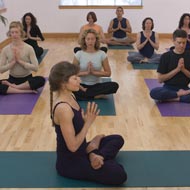Pranayama - Focus on the Breath in Your Yoga Routine
Pranayama is one of the oldest practices in India but has been presented to the whole world only recently. Pranayama breathing is an integral part of any yoga and meditation routine. The term pranayama refers to ‘prana’ or energy that is channeled through the correct process of breathing.
Also known as healthy breath or blissful breath, the purpose of pranayama in yoga is not to take over the body’s function but rather positively affect the various systems through an increased awareness of your breath. There is a philosophy behind the practice of pranayama that believes when you control your respiration and optimize your breath, you integrate awareness, reduce stress and improve the functioning of all the systems in your body.
Clinical studies have been conducted on the health benefits of pranayama.
The results are clear that deep breathing exercises can reduce the effects of stress, improve cardiovascular and respiratory function, decrease any nervous activity and enhance calm and peace of mind. These studies indicate that overall physical and mental health can improve with the regular practice of healing breath exercises. But it’s not as easy as it sounds. For some people mastering certain types of pranayama deep breathing can take a while. If this happens to you, do not despair, as it is completely normal. Only with practice and time, will your body and mind start working together and you will begin to reap the benefits of your yoga practice. There are several different types of deep breathing exercises that yoga teaches. These include the Complete Breath (where all parts of the lungs are engaged while breathing), Interval Breathing (where the amount of time spend inhaling and exhaling are changed), Alternate Nostril Breathing (where one cycle of breath involves inhalation through one nostril and exhalation through the other), and Belly Breathing (where deep breaths are controlled by the movements of the belly). These are just a few of the pranayama deep breathing exercises that you should include during your yoga routine. It is important that you practice the exercises slowly and with complete awareness. Before beginning any new routine or breathing exercise, it is also recommended that you do so under the guidance of your yoga instructor. Apart from the fact that there are certain breathing exercises that may aggravate health problems such as asthma or bronchitis, simply practicing the exercise incorrectly can have negative repercussions as well. It is therefore important that before you take up any breathing exercise you have complete knowledge of what you are doing or have someone trained to guide you through the exercise.
Read more articles from the Yoga Breathing (Pranayama) Category.

 Find Pose
Find Pose

